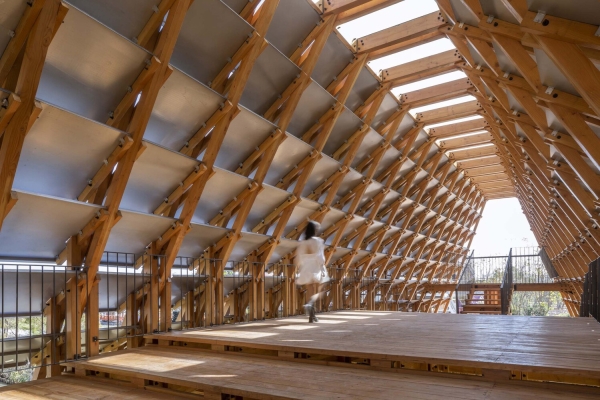In the current scenario of a climate crisis, thinking about an architectural project without defining ecological guidelines has become practically unacceptable. One of the main emitters of carbon dioxide and other pollutants, the construction sector is increasingly looking for new ways and means that can make works more sustainable and, in some way, mitigate damage to the environment. Thinking about ecological materials can be one of the fundamental steps, but, which materials are these?
By definition, to be considered ecological, a material must follow some general characteristics such as: be made from a raw material that is rapidly renewed, or that is recyclable, biodegradable or susceptible to conversion to carbon; their collection, extraction and manufacture must be done locally, avoiding distant displacements; its inputs must be organically or sustainably grown or harvested, and must be free of toxins; and be durable, easy to maintain and easy to reuse. Below, you will find some of the materials that meet these requirements:
▪ Adobe and Rammed Earth
Composed of raw earth, water, straw and, in some cases, other natural fibers, adobe is an ancient technique used all over the world. It is a low-impact material that is produced manually, does not use fossil fuels in its production and does not require energy to burn it. Therefore, the traditional material allows its rubble to be returned directly to the earth. Other advantages are its low cost, ease of production and implementation.
When adopting the material, it is necessary to pay particular attention to a deep understanding of the climate and the place where the structure will be built, as it is not suitable for seismic areas and should not be exposed to large amounts of rain, being necessary to think about the protection of its surfaces against rainwater or runoff.
Because they have similar materials, many people can confuse adobe with rammed earth, the main difference is in the technique adopted to design the product. While the first is a sun-baked brick and its construction process follows the form of masonry, the second normally consists of two parallel wooden panels or plywood sheets, filled with a layer of damp earth. After this small layer is added, it is compressed to about half its original volume by a pneumatic tamper. This process is repeated iteratively until the structure is filled with compacted earth, allowing the wood to be removed and a self-supporting rammed earth wall to remain.
▪ Bamboo
If we were to design the ideal building material, it would look a lot like bamboo. The millennial plant, widely used in Southeast Asia, has become increasingly popular in other territories due to its characteristics and benefits, which include low cost, easy handling and low energy for its preparation. The material that captures and stores carbon dioxide has demonstrated in laboratory tests that it achieves impressive structural capabilities. Its compressive strength is equivalent to that of concrete, while its tensile strength reaches the numbers of steel.
But it is necessary to remember that all this can vary according to the species, which are more than 1500 and grow naturally on almost all continents, especially in regions with higher temperatures. In addition, its installation requires a minimally qualified workforce. It must receive adequate treatment for pest protection, as well as it must not be in direct contact with the soil or rain.
▪ Certified or Planted Wood
Many people still ask themselves: Is using wood in architecture sustainable? As it is a renewable material, therefore, it is possible to use it without further damage to the environment as long as its extraction rate allows for the restoration of the forest and maintains the entire cycle sustainable. To guarantee this, there are different seals that verify the wood and guarantee its quality, such as the FSC (Forest Stewardship Council) and the INMETRO Brazilian Forest Certification System (Cerflor).
An already traditional building material, wood is capable of storing about a ton of carbon dioxide in each cubic meter. In addition, its easy handling allows the construction site to be more efficient, reducing construction time and consuming less energy for the construction of structures.
▪ Ecological Bricks
Known as compressed earth blocks, ecological bricks are modular and can be used for structural purposes - replacing other more materials that are harmful to the environment, such as concrete. They are composed of soil and cement and cured with water. In other words, they do not need any kind of burning. Due to their texture, they can be kept in their apparent forms, making coatings unnecessary.
By adopting it, there is an economy of 70% in concrete and mortar, and 50% in steel, in construction. Its benefits, in general, reduce construction time by 30% compared to traditional masonry, it makes the site cleaner as it reduces waste from the work and, finally, they can have the pipe embedded in their holes.
________________________________________________________________________________________________________________________________________________________
▪ Source: Archdaily|https://www.archdaily.com/983303/which-building-construction-materials-are-ecological
▪ Written by ArchDaily Team | Translated by Diogo Simões
▪ Images Credit:
01/ Timber Bridge in Gulou Waterfront / LUO studio. Photo: © Weiqi Jin
02/ Refúgio "Ruta del Peregrino" / Luis Aldrete. Photo: © Francisco Perez
03/ Cave House in Loess Plateau / hyperSity Architects. Photo courtesy of hiperSity Architects
04/ Urban Park Micro Renovation / Atelier cnS + School of Architecture, South China University of Technology. Photo: © Siming Wu
05/ Bamboo Pavilion / DnA. Photo: © Zhou Ruogu/Savoye Photographer
06/ Escola Concept / Triptyque Architecture. Photo: © Fran Parente
07/ Sauna Malabar / Bela Gebara Arquitetura. Photo: © Rodrigo Pacheco
08/ Biotrends Factory / Rede Arquitetos. Photo: © Igor Ribeiro
09/ GSM House / OTP arquitetura. Photo: © Guilherme Pucci


